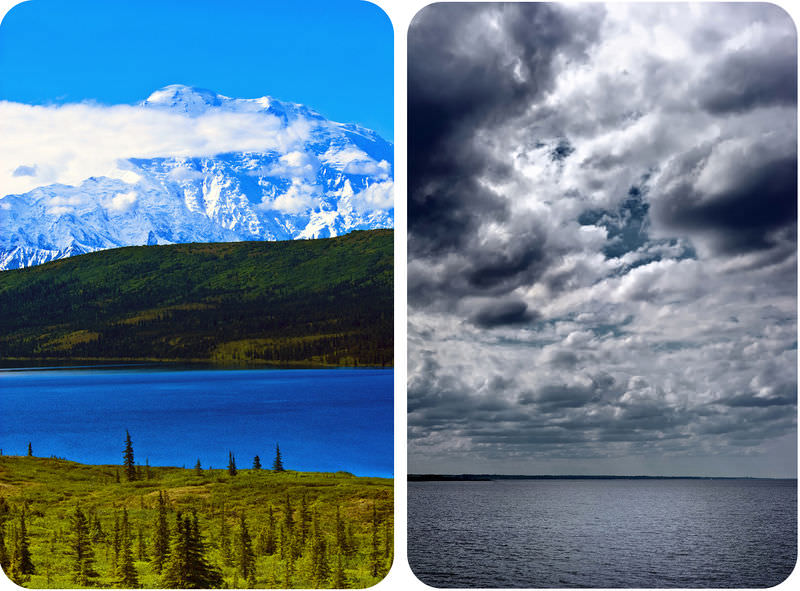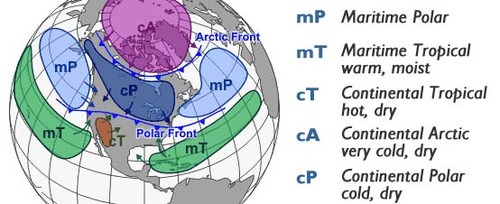11.6气团
章节大纲
-
Lesson
::经验教训Pick an air mass!
::挑一个空气弥撒!A cold dry air mass forms over the interior of Alaska. The mountain is Mt. McKinley in Denali National Park. A warm wet air mass forms over the ocean. It sneaks onto the coastal area. Which region would you like to visit?
::在阿拉斯加内地形成一个冷干气团,山是Denali国家公园的McKinley山,在海洋上形成一个温暖的潮湿空气团,潜入沿海地区。您想参观哪个地区?Air Masses
::空气质量An air mass is a large body of air that has about the same conditions throughout. For example, an air mass might have cold dry air. Another air mass might have warm moist air. The characteristics of an air mass depend on where the air mass formed. The air must stay over that long enough to pick up those characteristics.
::空气质量是整个空气中条件大致相同的大块空气。 例如,空气质量可能有冷干空气; 空气质量可能有温暖的潮湿空气。 空气质量的特点取决于空气质量的形成位置。 空气必须保持足够长的时间来接收这些特征。Formation of Air Masses
::空气质量形成Most air masses form over polar or tropical regions. They may form over continents or oceans. Air masses are moist if they form over oceans. They are dry if they form over continents. Air masses that form over oceans are called maritime air masses. Those that form over continents are called continental air masses. The image below shows air masses that form over or near North America ( Figure ).
::多数空气质量由极地或热带地区形成, 可能由大陆或海洋形成。 空气质量如果由海洋形成, 就会潮湿。 如果由大陆形成, 空气质量就会干燥。 海洋空气质量被称为海洋空气质量。 大陆空气质量则被称为大陆空气质量。 下面的图像显示在北美上空或附近形成的空气质量( 图 ) 。North American air masses.
::北美空气质量。An air mass takes on the conditions of the area where it forms. For example, a continental polar air mass has cold dry air. A maritime polar air mass has cold moist air. Which air masses have warm moist air? Where do they form?
::例如,大陆极地空气有冷干空气; 海洋极地空气有冷潮湿空气; 哪一种空气有温暖潮湿空气? 它们在哪里形成?Movement of Air Masses
::大规模空运运动When a new air mass moves over a region it brings its characteristics to the region. This may change the area's and . Moving air masses cause the to change when they contact different conditions. For example, a warm air mass moving over cold ground may cause an inversion .
::当一个新的空气质量在某个区域移动时,它会给该地区带来其特性。这可能会改变该地区的特性。移动空气质量会在它们接触不同条件时导致变化。例如,在寒冷地面移动的温暖空气质量可能导致反向。Why do air masses move? Winds and jet streams push them along. Cold air masses tend to move toward the equator . Warm air masses tend to move toward the poles. The causes them to move on a diagonal. Many air masses move toward the northeast over the U.S. This is the same direction that global winds blow.
::为什么空气质量会移动?风和喷气流会把它们推向赤道。冷气团会朝赤道方向移动。暖气团会朝极方向移动。它们会沿着对角移动。许多空气团会向东北移动,在美国上空。这是全球风吹向的方向。Further Reading
::继续阅读Summary
::摘要- An air mass has roughly the same temperature and humidity.
::空气质量的温度和湿度大致相同。
- Air masses form over regions where the air is stable for a long enough time. The air takes on the characteristics of the region.
::空气在空气稳定一段时间的区域形成空气质量,空气随区域特点的变化而变化。
- Air masses move when they are pushed by high level winds.
::空气质量在被高强度风推动时移动。
Review
::回顾- What is an air mass?
::什么是空气质量?
- Why do air masses form where the air stays in one place for a while?
::为什么空气质量会形成空气在一个地方停留一段时间的地方?
- What happens when an air mass moves over a new region?
::当空气在一个新的区域移动时会怎样呢?
- An air mass has roughly the same temperature and humidity.

